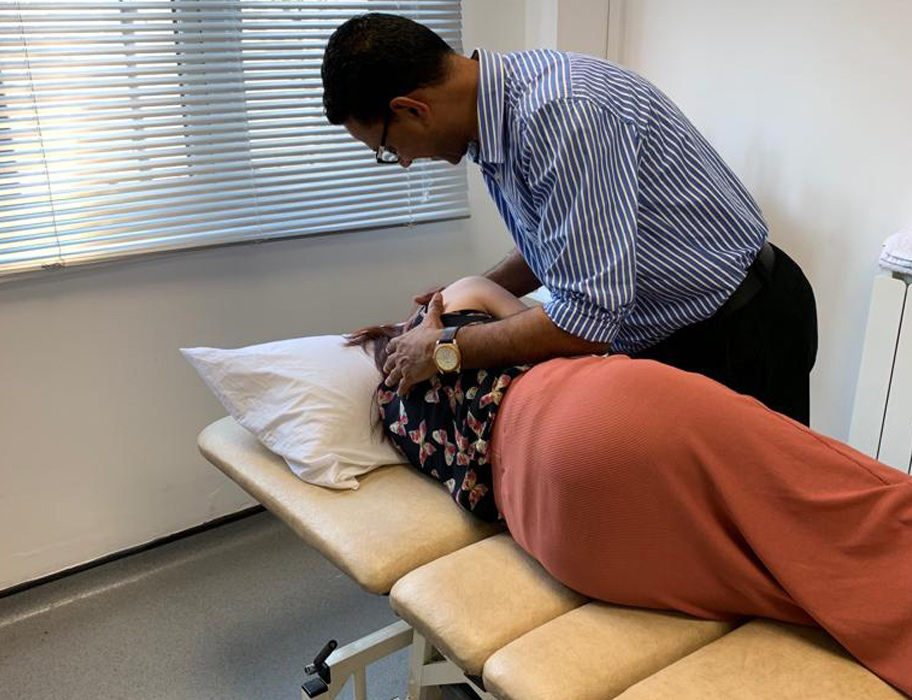Lateral ligament sprains of the Ankle
Lateral ligament injuries are perhaps one of the most common sports-related injuries seen by physiotherapists. Usually a result of a forced plantar flexion/inversion movement , the complex of ligaments on the lateral side of the ankle is torn by varying degrees. Although the "sprained ankle" is a relatively benign injury, inadequate rehabilitation can lead to a chronically painful ankle, reduced functional ability and increased likelihood of re-injury. Care should also be taken to avoid missing the less common causes of ankle pain, namely; small fractures around the ankle and foot (e.g. Pott's fracture) and straining or rupture of the muscles around the ankle (e.g. calf, peroneii, tibialis anterior).
Treatment and rehabilitation:
Initial management (i.e. within the first 48-72 hours) of an acute lateral ligament injury is to reduce pain and swelling by following the RICE regimen; Rest, Ice, Compression and Elevation.
If WB is too painful, the patient can be given elbow crutches and be non-weight bearing (NWB) for 24 hours. However, it's important that at least partial weight bearing (PWB) is initiated relatively soon, together with a normal heel-toe gait pattern, as this will help to reduce pain and swelling.
Gentle soft tissue Massage (STM) can be performed to assist with the removal of oedema and gentle stretches, as long as this is pain free.
As soon as pain allows, the patient should begin pain free active range of movement (ROM) exercises.Eversion is especially important.
Restore proprioception
Proprioception training should begin as soon as pain allows during the rehabilitation programme.
Return to functional activity:Patients should be assessed for the ability to do the following activities pain free:
Twisting, Jumping, Hopping on one leg, Running, Figure of 8 running.
Before returning to full functional activity the patient should have full range of pain free movement in the ankle, normal strength and normal proprioception. If returning to sports, the athlete should be encouraged to wear an ankle brace or to tape the ankle for a further 6 months to provide external support. Types of taping include a heel lock and figure of 6.
Grade 3 sprains
While in the past surgery was advocated for grade 3 sprains, it's now considered that an initial 6 week conservative programme should only be followed by surgery should pain not be relieved. A recent review of the literature in the Cochrane database found little to recommend surgery over conservative management.
An injury to the lateral collateral ligament (LCL) of the knee can be caused by a varus stress, lateral rotation of the knee when weight-bearing or when the LCL loses it's elasticity caused by repeated stress .The LCL can be sprained (grade I), partially ruptured (grade II) or completely ruptured (grade III) . Additional damage of the anterior cruciate ligament (ACL), posterior cruciate ligament (PCL) and medial knee structures is possible when the lateral knee structures are injured
then a patient suffers a direct impact to the inner surface of the knee joint, the therapist can automatically assume that the lateral collateral ligament is damaged because of an abnormal stretch of the ligament caused by the joint from gapping at the outer surface. The first thing to do is applying the RICE method. The doctor may give some NSAIDs and a brace. The patient's injured knee is placed in a functional rehabilitative brace with limits set 0 extension and 90 flexion to control ligament stress yet still allow motion. The brace is worn for three to six weeks. When the pain and swelling are reduced, you can start with excersises to restore the strength, normal range of motion, aerobic conditioning, technique refinement and proprioceptive retraining. Electrical stimulation can also prevent the muscles wasting due to immobilization.
Strength:
A combination of open and closed kinetic chain exercises is used to increase hamstrings, quadriceps, gluteal and triceps sural strength. The goal of these exercises is to improve the control of the knee joint with weight-bearing activities.These exercises must not produce patellofemoral pain or increase collateral ligament pain. Once the patient is ambulating in full weight bearing, stork standing (Therapist flexes patients hip on the involved side to 90 degrees and applies direct downward force through the femur while stabilizing sacrum) and other balance activities can begin .The patient can be treated with specific techniques, including isometric, isotonic, isokinetic and eccentric exercices. If full motion is not achieved by around week 5 or 6, joint mobilization techniques and prolonged stretches may be required.Walking on the treadmill with progression to jogging occurs once a normal walking gait has been achieved. Jogging then progresses to running and sprinting as long as pain and edema are avoided.
Proprioceptive retraining:
Just as with others injured areas, balance, agility, and coordination must be restored following knee injury or surgery. Proprioception is the element basic to these parameters. Early proprioception exercises before weight bearing can include a variety of activities. For example, with eyes closed the patient can move the involved knee to mimic the uninvolved knee's position, or with eyes closed can position the knee at a designated angle.
Massage and ultrasound are also a part of the treatment. The revalidation takes 2- 8 weeks, depending on the severity of the injury.
Most of the time an injury of ligaments will take quite a long time, because of the difference in density. It's important to work as well psychical as physical.
LCL injuries can be grouped into classes. Grade I injuries show normal or up to 5 mm of joint space opening with a solid endpoint. A similar solid endpoint is observed with grade II injuries, but opening up to 10mm. Grade III injuries demonstrate greater than 10 mm of joint space opening and often are associated with other ligament injuries. There are differences in treatment in the classes. With grade I and II injuries, a brace at 45 degrees for 4-6 weeks is enough. Progressive range of motion after 3 weeks as comfort allows enables progression in rehabilitation. But with an injury grade III there is a surgery necessary due to rotational instability, because they usually involve the posterolateral cornor of the knee. After the surgery, you need a brace and physical therapy for prevent the instability.
Periodic evaluations at 2 to 4 weeks are required for operative and nonoperative management.

HOW CAN WE HELP YOU?
Call us at 01293529090 or click here to make a booking online or email us at info@prorehab.co.uk for more information.

-
Conditions

